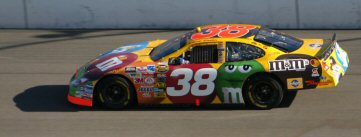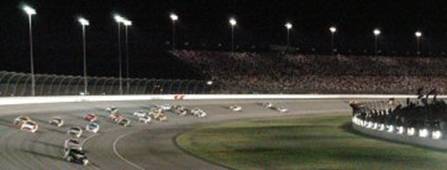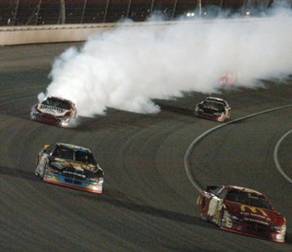
NASCAR Under the Lights at California Speedway
For the second time this year I went to a NASCAR NEXTEL CUP SERIES race at California Speedway. The “Pop Secret 500” provided a much different and even more exciting day.
My day began from a vantage point overlooking the pits, in the Terrace Grandstands. Located directly above the Media Center, this location also provided a pretty good, if not a little bit distant, view of the start/finish line and the cars taking the green flag to start the race.
Pre-race entertainment included precision skydivers and a fly-over. There was also some filming done for a new car movie that is in production.
Remember Herbie, The Love Bug? I think it was a Disney movie from the 60s. Anyway, the latest version of that ‘classic’ apparently will have Herbie racing with cars on the NASCAR NEXTEL CUP circuit. To realistically show that, the real race start was held up long enough to shoot some footage of Herbie and the NASCAR boys tearing up the track. What a hoot!
That done and out of the way, the race began shortly thereafter and everyone seemed to get off to a clean start, despite the relatively high number of caution periods that would occur before the race was over. Those of you who seriously follow NASCAR racing probably know the detailed race story already so, rather than repeat old news, I’ll show you some of the racing action and describe some of what the TV and sports-page guys and gals rarely mention. I hope you’ll find it interesting.
This race was special in that it began in daylight and finished under the lights. That introduced some exciting new elements to NASCAR racing at California Speedway – and probably accounted for some of the increased number of caution periods. For one thing, the drivers had to race directly into the sun as they exited turn two near sunset time. They did so lap after lap, at speeds greater than 180 mph. Pit crews applied dark tape to serve as sun visors on the racecars’ windshields. Also, apparently drivers picked and used specific palm trees lining the back straight of the track to serve as reference points for slowing down for turn three.
Something that made the day-into-night racing especially challenging for the race teams were the changes in track temperature. That affected how the cars handled throughout the race, so to remain competitive the teams had to constantly chase and fine-tune their setups as the track cooled off.
Another problem was downright weird. Large quantities of trash were flying around, blocking air intakes of the cars and causing engine overheating. A lot of it looked like paper hotdog wrappers. Some drivers followed other cars to try to use the draft to remove the debris. Others had to make unscheduled pit stops to clean out the debris or their cars would have cooked their engines. It was so bad that at one point NASCAR officials had to throw a caution just to go out to clean up the garbage, which was everywhere: on the track, stuck in the chain link fences and on the grassy area between the front straight and the pits.
For me the most exciting part of raceday happened pretty much by accident (no pun intended). Bear in mind that California Speedway is HUGE. Also, since it is located in Fontana it is extremely HOT. The outside temperature was around 100 degrees. The last races I’d attended there were all day races. Add all that up and you can probably understand why I have not yet done too much exploring there. There is a limit to how much walking I am prepared to do in that kind of heat, so I had not come close to fully exploring my photo opportunities.
That is why this time, in the heat of the afternoon, I spent the first half of the race shooting photos from the media grandstand on the infield side of the track. I was quite far removed from the racing action. To get photos I really needed to take maximum advantage of my camera’s zoom lens. Furthermore, for my second race there in a row I was not granted hot pit access. That really makes a difference. My hot pit photos from this year’s Long Beach Grand Prix (Champ Cars) had a much more captivating visual presence. Nevertheless, I was still able to make do and take some decent photos from above. Eventually I decided to take a break for dinner and re-energize.
After dinner I looked in on some of the photographers seated in front of their laptop computers in the Photo Center. On one’s computer monitor he had great close-up photos of racing action. They seemed to have been taken from a point of view on the outside of the track. I decided to leave and look for a shuttle to get other photo opportunities.
The shuttle driver was extremely helpful. I explained to him what I wanted and he knew exactly where to take me. We drove through the tunnel under the track and then around to the outside of the turn one, at the end of the front straight. Where was this person the last time I’d been here?!
He took me as close as he could in the shuttle and then he got out and personally escorted me the rest of the way on foot. He led me through a gate and over to what he called “the cage.” Before he left he told me that there were also additional cutouts in the fence for more photo opportunities around the track. I sincerely thanked him for his help. The people who work at California Speedway really do seem to be dedicated to providing a great experience for visitors.
“The cage” is basically a small, rectangular enclosure formed from plain chain link fencing material, and it overlooks the entrance to turn one. There was absolutely nothing between me in “the cage” and the racecars on the track, except for the half-height track wall and its “safer barrier.” I was protected only from the waist down. If an accident had happened my only hope of survival would have been to drop down – if I could see it coming while taking photographs and then react instantly. Exciting stuff. Perhaps that is why I had the entire cage to myself most of the time.
The good news is that I survived and took some photographs. There is no bad news unless you take into account the fact that it was dark out and I only had the illumination provided by the track lighting to work with. It took some heavy-duty experimentation with my camera to achieve an acceptable balance between getting enough light in to expose my camera’s imaging sensor, and shooting at a high enough shutter speed to end up with more than just colorful blurs speeding by. If the night photos look a little “grainy” that is why. I really need a lens more suited to low light photography.
My experience in “the cage” was absolutely fantastic. The cars would go racing by, singly and in groups, with each one making their own loud “whoosh.” I was almost close enough to reach out through the cutout in the fence and touch them. I remember being concerned that the credentials that were hung around my neck might blow off and onto the track. I cannot begin to describe the huge adrenalin rush. Suffice to say I had never in my life had a more exciting vantage point from which to watch a race. Little did I know at the time that soon things would get too exciting even for me.
I can’t recall the exact order of what followed but this is more or less what happened next. I decided to check out some of the other vantage points before the race ended, and walked immediately behind the wall between turns one and two. Soon I came to another cutout in the fence. In this one, on the wall, a robotic camera was mounted. I carefully dodged it as it swiveled back and forth, taking pictures of the racing action through the cutout in the fence. So far, so good. I walked some more.
Now I was approaching the outside of turn two. I found another cutout in the fence and took a photo of a car billowing smoke, as its engine expired in a big way. First I saw the car trailing smoke in the distance. Then I saw it trailing smoke closer up. Then the cloud of smoke blew through the fence and completely surrounded me. At that point I decided that just in case any engine or other parts followed, it might be a good idea for me to duck behind the half-height barrier. I did.
Still alive and well, I then moved to the outside of turn two. At one vantage point another robotic camera was mounted in another hole in the fence. Earlier in the race a couple cars had collided at about that very spot. The camera was practically right on top of the accident scene.
Since the cameras made it difficult for me to position myself for taking photos, I moved on to the next opening in the fence. I got there during one of the late race caution periods so I stuck my camera through the opening in the fence and got some great pictures of packs of racecars going by. Even as they were led by the Chevy pace truck, they were almost moving too fast to focus on. Between the low light and the need to manually focus my camera, I had my hands full. I was, however, about to find out why robotic cameras are used.
The caution period ended and the track went back to green. I heard the cars approaching, this time at speed. Like an unsuspecting fool I stood there and poked my camera through the opening, ready to take more pictures.
Have you ever been sandblasted? Well I was, although on a very small scale. Even though I couldn’t see what was hitting me, it was as if someone was shooting needles my way. As I found out later, I was probably being pelted by little balled up bits of rubber. The cars were roaring by me faster than I could focus on them – and, as I was also told later, the IRL cars that race here probably go 50 mph FASTER in the same place! I doubted I would be able to see if car parts started flying my way and quickly decided that this was not a very good place for me to stand. My life is more important than the photo ops at that location so I moved on to a safer location to shoot the end of the race.
Throughout the evening I’d had incredible vantage points for photos. As good as my pictures were in the artificial light that flooded the track, I’m sure that when I return for a daytime race my photos will be even better, due to the high shutter speeds needed for sharp action photography.
My last pleasant surprise came shortly after the race ended. Beyond the back straight I began to hear what sounded like small explosions. I turned around to see that a post-race fireworks show had begun, and there was nothing between me and it. It was absolutely fantastic. I shot some more pictures and then began the very long walk back to the Media Center in the infield.
As hard as it was to believe, more good things were still waiting for me. At about this point at the last race I went to the post-race Press conference. However, there was no way I could do that this time. I was too far away. So, instead, I decided to buck the mobs already leaving the track and check out some of the many vendors.
By the time I got to the vendor aisle it was pretty late. They were starting to pack up, but at several they were also holding post-race sales. At one I bought last year’s Kyle Petty racing jacket. It had previously sold for $140 but they were clearing them out for an unbelievable $40. Yes!
Now I really needed to get back to the Photo Center, return my Photo armband and get back on the road to San Diego. Racecar transporters were already leaving the track, driving past fans who were standing by the roadside cheering for their favorite teams.
Soon I arrived at the garage area. Inside there were still several racecars, surrounded by people working on them. The post-race teardown of the winning cars was in progress. I focused in on the winning Robert Yates Racing #38 M&Ms Ford, driven to victory by Elliott Sadler. Can you guess who was up to his elbows in grease and oil, helping to remove and tear down the engine? None other than racing legend Robert Yates himself! It did not look like he appreciated my photographing him, since he spoke to a NASCAR official and they looked my way. I acknowledged them and assured two NASCAR officials that I was not trying to steal their engine secrets.
My last surprise of the evening came as I was walking towards my parked car. I saw a racing fan standing beside a Goodyear truck. He was proudly holding a big race tire. On impulse I went up to the trailer and asked if I could have one too. They gave me one! Now I have to figure out how best to make it into a souvenir. Perhaps I’ll make a table out of it.
From its humble origins, NASCAR racing has grown into a huge spectator sport, even here in Southern California. The crowd for this race was estimated at 90,000. The total purse was a whopping $5,836,554. Of that, the winner’s portion was $279,398 and even last place was worth $75,875.
This was truly a wonderful day. What an absolutely incredible experience. Thank you California Speedway, NASCAR and Goodyear.
For information on upcoming races at California Speedway, including this year’s IRL and NASCAR Craftsman Truck Series weekend, and then the Grand American weekend on the road course, go to www.californiaspeedway.com or call (800) 944-RACE. Next year’s six-race season ticket packages will go on sale Oct. 6.
Drive safely and do join me again next time.













